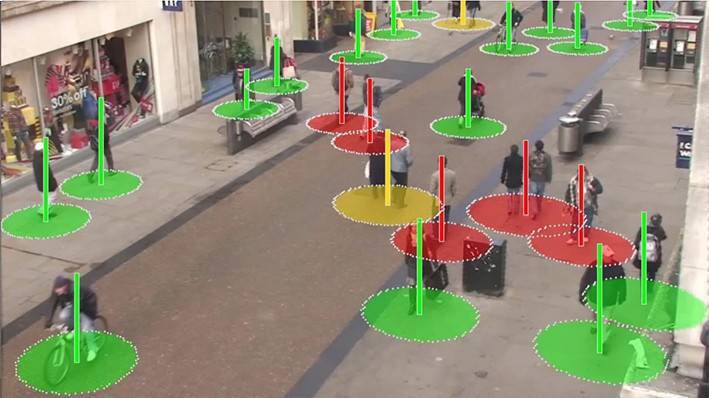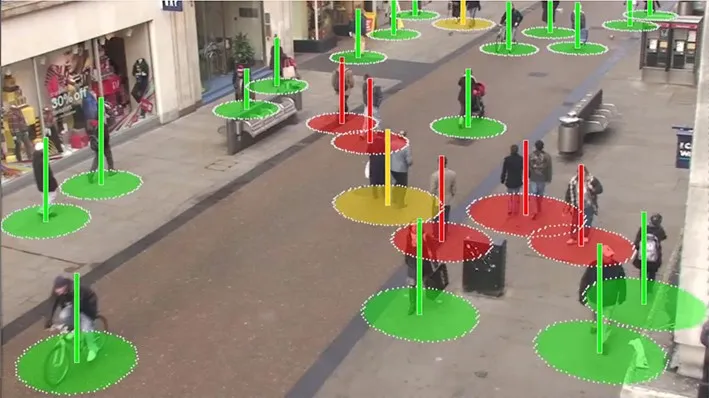基于 ModelArts 进行流感患者密接排查
- 2023-02-03 中国香港
本文字数:5555 字
阅读完需:约 18 分钟

本文分享自华为云社区《基于ModelArts进行流感患者密接排查》,作者:HWCloudAI。
目前流感病毒患者密接难以排查,尤其是在人流量大的区域,进行排查需要消耗大量人力且需要等待。针对疫情期间存在的排查实时性差、排查效率低、无法追踪密接者等问题,可以使用基于 YOLOv4 的行人检测、行人距离估计、多目标跟踪的方案进行解决。
1)利用行人重识别技术实现流感病毒患者及密接者识别功能;
2)结合 Stereo-vision 以及 YOLO 算法实现患者的真实密切接触鉴别;
3)利用 SORT 多目标跟踪算法绘制出患者及密接者的行动轨迹;

该系统可以有效提高防疫效率,减轻经济与防疫压力,提高安全性。
今天将带大家了解 通过华为云 ModelArts 的 DeepSocial-COVID-19 社会距离监测案例实现 AI 排查新冠密接。
点击链接进入到 AI Gallery 的“DeepSocial-COVID-19 社会距离监测”案例页面,点击 Run in ModelArts,即可进入 ModelArts Jupyter 运行环境,此处需要选用 GPU 的规格。
注:以下步骤所涉及的代码都已经写好,直接点击代码前面的箭头,让其自动运行即可。
步骤一:从华为云对象存储服务(OBS)拷贝案例所需代码。
# 下载代码和数据import moxing as moxmox.file.copy_parallel('obs://obs-aigallery-zc/clf/code/DeepSocial','DeepSocial')# 引入依赖from IPython.display import display, Javascript, Imagefrom base64 import b64decode, b64encodeimport osimport cv2import numpy as npimport PILimport ioimport htmlimport timeimport matplotlib.pyplot as plt%matplotlib inline步骤二:在本地编译 YOLO。
需要根据运行环境修改 Makefile 如是否有 GPU 等
如果编译报错:/bin/sh:nvcc not found
解决方式(参考):
1)查看 nvcc 可执行文件的路径
which nvcc
2)修改 Makefile 文件中的 NVCC=nvcc,把 nvcc 替换为上面查询到的 nvcc 可执行文件的路径,如:/usr/local/cuda/bin/nvcc
NVCC=/usr/local/cuda/bin/nvcc
%cd DeepSocial!make步骤三:使用 Darknet 的 python 接口
# import darknet functions to perform object detectionsfrom darknet2 import *# load in our YOLOv4 architecture networknetwork, class_names, class_colors = load_network("cfg/yolov4.cfg", "cfg/coco.data", "DeepSocial.weights")width = network_width(network)height = network_height(network)# darknet helper function to run detection on imagedef darknet_helper(img, width, height): darknet_image = make_image(width, height, 3) img_rgb = cv2.cvtColor(img, cv2.COLOR_BGR2RGB) img_resized = cv2.resize(img_rgb, (width, height), interpolation=cv2.INTER_LINEAR) # get image ratios to convert bounding boxes to proper size img_height, img_width, _ = img.shape width_ratio = img_width/width height_ratio = img_height/height # run model on darknet style image to get detections copy_image_from_bytes(darknet_image, img_resized.tobytes()) detections = detect_image(network, class_names, darknet_image) free_image(darknet_image) return detections, width_ratio, height_ratio步骤四:使用 SORT 来实时跟踪目标
!pip install filterpyfrom sort import *mot_tracker = Sort(max_age=25, min_hits=4, iou_threshold=0.3)步骤五:输入设置
Input = "OxfordTownCentreDataset.avi" # 需要检测的适配ReductionFactor = 2 # 采样因子calibration = [[180,162],[618,0],[552,540],[682,464]] # 相机标定的参数步骤六:DeepSocial 参数设置和函数引入
from deepsocial import *######################## Frame numberStartFrom = 0 EndAt = 500 #-1 for the end of the video######################## (0:OFF/ 1:ON) OutputsCouplesDetection = 1 # Enable Couple Detection DTC = 1 # Detection, Tracking and Couples SocialDistance = 1CrowdMap = 1# MoveMap = 0# ViolationMap = 0 # RiskMap = 0######################## Units are PixelViolationDistForIndivisuals = 28 ViolationDistForCouples = 31####CircleradiusForIndivsual = 14CircleradiusForCouples = 17######################## MembershipDistForCouples = (16 , 10) # (Forward, Behind) per PixelMembershipTimeForCouples = 35 # Time for considering as a couple (per Frame)######################## (0:OFF/ 1:ON)CorrectionShift = 1 # Ignore people in the margins of the videoHumanHeightLimit = 200 # Ignore people with unusual heights########################Transparency = 0.7######################## Output Video's pathPath_For_DTC = os.getcwd() + "/DeepSOCIAL DTC.mp4"Path_For_SocialDistance = os.getcwd() + "/DeepSOCIAL Social Distancing.mp4"Path_For_CrowdMap = os.getcwd() + "/DeepSOCIAL Crowd Map.mp4"def extract_humans(detections): detetcted = [] if len(detections) > 0: # At least 1 detection in the image and check detection presence in a frame idList = [] id = 0 for label, confidence, bbox in detections: if label == 'person': xmin, ymin, xmax, ymax = bbox2points(bbox) id +=1 if id not in idList: idList.append(id) detetcted.append([int(xmin), int(ymin), int(xmax), int(ymax), idList[-1]]) return np.array(detetcted)def centroid(detections, image, calibration, _centroid_dict, CorrectionShift, HumanHeightLimit): e = birds_eye(image.copy(), calibration) centroid_dict = dict() now_present = list() if len(detections) > 0: for d in detections: p = int(d[4]) now_present.append(p) xmin, ymin, xmax, ymax = d[0], d[1], d[2], d[3] w = xmax - xmin h = ymax - ymin x = xmin + w/2 y = ymax - h/2 if h < HumanHeightLimit: overley = e.image bird_x, bird_y = e.projection_on_bird((x, ymax)) if CorrectionShift: if checkupArea(overley, 1, 0.25, (x, ymin)): continue e.setImage(overley) center_bird_x, center_bird_y = e.projection_on_bird((x, ymin)) centroid_dict[p] = ( int(bird_x), int(bird_y), int(x), int(ymax), int(xmin), int(ymin), int(xmax), int(ymax), int(center_bird_x), int(center_bird_y)) _centroid_dict[p] = centroid_dict[p] return _centroid_dict, centroid_dict, e.imagedef ColorGenerator(seed=1, size=10): np.random.seed = seed color=dict() for i in range(size): h = int(np.random.uniform() *255) color[i]= h return colordef VisualiseResult(_Map, e): Map = np.uint8(_Map) histMap = e.convrt2Image(Map) visualBird = cv2.applyColorMap(np.uint8(_Map), cv2.COLORMAP_JET) visualMap = e.convrt2Image(visualBird) visualShow = cv2.addWeighted(e.original, 0.7, visualMap, 1 - 0.7, 0) return visualShow, visualBird, histMap步骤七:推理过程
cap = cv2.VideoCapture(Input)frame_width = int(cap.get(3))frame_height = int(cap.get(4))height, width = frame_height // ReductionFactor, frame_width // ReductionFactorprint("Video Reolution: ",(width, height))if DTC: DTCVid = cv2.VideoWriter(Path_For_DTC, cv2.VideoWriter_fourcc(*'X264'), 30.0, (width, height))if SocialDistance: SDimageVid = cv2.VideoWriter(Path_For_SocialDistance, cv2.VideoWriter_fourcc(*'X264'), 30.0, (width, height))if CrowdMap: CrowdVid = cv2.VideoWriter(Path_For_CrowdMap, cv2.VideoWriter_fourcc(*'X264'), 30.0, (width, height))colorPool = ColorGenerator(size = 3000)_centroid_dict = dict()_numberOFpeople = list()_greenZone = list()_redZone = list()_yellowZone = list()_final_redZone = list()_relation = dict()_couples = dict()_trackMap = np.zeros((height, width, 3), dtype=np.uint8)_crowdMap = np.zeros((height, width), dtype=np.int) _allPeople = 0_counter = 1frame = 0while True: print('-- Frame : {}'.format(frame)) prev_time = time.time() ret, frame_read = cap.read() if not ret: break frame += 1 if frame <= StartFrom: continue if frame != -1: if frame > EndAt: break frame_resized = cv2.resize(frame_read,(width, height), interpolation=cv2.INTER_LINEAR) image = frame_resized e = birds_eye(image, calibration) detections, width_ratio, height_ratio = darknet_helper(image, width, height) humans = extract_humans(detections) track_bbs_ids = mot_tracker.update(humans) if len(humans) != 0 else humans _centroid_dict, centroid_dict, partImage = centroid(track_bbs_ids, image, calibration, _centroid_dict, CorrectionShift, HumanHeightLimit) redZone, greenZone = find_zone(centroid_dict, _greenZone, _redZone, criteria=ViolationDistForIndivisuals) if CouplesDetection: _relation, relation = find_relation(e, centroid_dict, MembershipDistForCouples, redZone, _couples, _relation) _couples, couples, coupleZone = find_couples(image, _centroid_dict, relation, MembershipTimeForCouples, _couples) yellowZone, final_redZone, redGroups = find_redGroups(image, centroid_dict, calibration, ViolationDistForCouples, redZone, coupleZone, couples , _yellowZone, _final_redZone) else: couples = [] coupleZone = [] yellowZone = [] redGroups = redZone final_redZone = redZone if DTC: DTC_image = image.copy() _trackMap = Apply_trackmap(centroid_dict, _trackMap, colorPool, 3) DTC_image = cv2.add(e.convrt2Image(_trackMap), image) DTCShow = DTC_image for id, box in centroid_dict.items(): center_bird = box[0], box[1] if not id in coupleZone: cv2.rectangle(DTCShow,(box[4], box[5]),(box[6], box[7]),(0,255,0),2) cv2.rectangle(DTCShow,(box[4], box[5]-13),(box[4]+len(str(id))*10, box[5]),(0,200,255),-1) cv2.putText(DTCShow,str(id),(box[4]+2, box[5]-2),cv2.FONT_HERSHEY_SIMPLEX,.4,(0,0,0),1,cv2.LINE_AA) for coupled in couples: p1 , p2 = coupled couplesID = couples[coupled]['id'] couplesBox = couples[coupled]['box'] cv2.rectangle(DTCShow, couplesBox[2:4], couplesBox[4:], (0,150,255), 4) loc = couplesBox[0] , couplesBox[3] offset = len(str(couplesID)*5) captionBox = (loc[0] - offset, loc[1]-13), (loc[0] + offset, loc[1]) cv2.rectangle(DTCShow,captionBox[0],captionBox[1],(0,200,255),-1) wc = captionBox[1][0] - captionBox[0][0] hc = captionBox[1][1] - captionBox[0][1] cx = captionBox[0][0] + wc // 2 cy = captionBox[0][1] + hc // 2 textLoc = (cx - offset, cy + 4) cv2.putText(DTCShow, str(couplesID) ,(textLoc),cv2.FONT_HERSHEY_SIMPLEX,.4,(0,0,0),1,cv2.LINE_AA) DTCVid.write(DTCShow) if SocialDistance: SDimage, birdSDimage = Apply_ellipticBound(centroid_dict, image, calibration, redZone, greenZone, yellowZone, final_redZone, coupleZone, couples, CircleradiusForIndivsual, CircleradiusForCouples) SDimageVid.write(SDimage) if CrowdMap: _crowdMap, crowdMap = Apply_crowdMap(centroid_dict, image, _crowdMap) crowd = (crowdMap - crowdMap.min()) / (crowdMap.max() - crowdMap.min())*255 crowd_visualShow, crowd_visualBird, crowd_histMap = VisualiseResult(crowd, e) CrowdVid.write(crowd_visualShow) cv2.waitKey(3)print('::: Analysis Completed')cap.release()if DTC: DTCVid.release(); print("::: Video Write Completed : ", Path_For_DTC)if SocialDistance: SDimageVid.release() ; print("::: Video Write Completed : ", Path_For_SocialDistance)if CrowdMap: CrowdVid.release() ; print("::: Video Write Completed : ", Path_For_CrowdMap)步骤八:展示结果
from IPython.display import HTMLoutpath = "DeepSOCIAL DTC.mp4"mp4 = open(outpath,'rb').read()data_url = "data:video/mp4;base64," + b64encode(mp4).decode()HTML("""<video width=400 controls> <source src="%s" type="video/mp4"></video>""" % data_url)如果想要更好的效果,如何进行优化呢?
1.使用精确度更高的检测算法 YOLOv7,使用追踪效果更好的 Deep SORT;
2.使用更多数据进行训练
本次介绍就到这里啦,大家快去 Gallery 实操一下吧!
版权声明: 本文为 InfoQ 作者【华为云开发者联盟】的原创文章。
原文链接:【http://xie.infoq.cn/article/68277e1afb52fbbdb2b9f7ab6】。文章转载请联系作者。
华为云开发者联盟
提供全面深入的云计算技术干货 2020-07-14 加入
生于云,长于云,让开发者成为决定性力量











评论